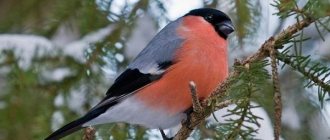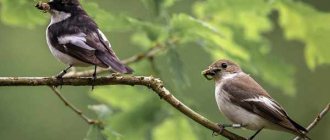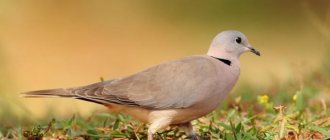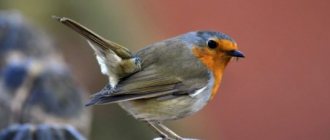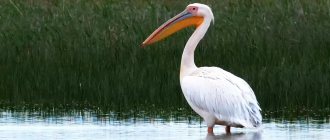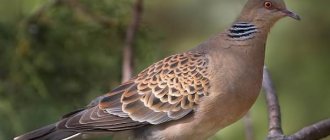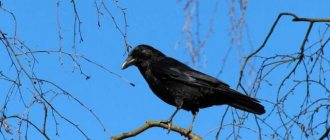- Wild animals
- >>
- Birds
The shoebill is a large aquatic bird that is unmistakably identifiable by its unique “shoe-shaped” bill, which gives it an almost prehistoric appearance, reminiscent of birds' descent from dinosaurs. The species is found in nine countries in Africa and has a large range, but is found in small local populations concentrated around swamps and wetlands.
Origin of the species and description
Photo: Kitoglav
Shoebill was known to the ancient Egyptians and Arabs, but was not classified until the 19th century, when living specimens were brought to Europe. John Gould described the species in 1850, naming it Balaeniceps rex. The genus name comes from the Latin words balaena "whale" and caput "head", abbreviated -ceps in compounds. The Arabs call this bird abu markub, which means “slipper.”
Video: Shoebill
Traditionally associated with storks (Ciconiiformes), it was retained in the Sibley-Ahlquist taxonomy, which grouped a huge number of unrelated taxa into the "Ciconiiformes". More recently, the shoebill was thought to be closer to pelicans (based on anatomical comparisons) or to herons (based on biochemical evidence).
Interesting fact: Microscopic analysis of the structure of eggshells in 1995 allowed Konstantin Mikhailov to discover that shoebill shells resembled the structure of pelican shells.
The coating itself consisted of a thick microglobulin material over crystalline shells. Recent DNA research confirms their belonging to Pelecaniformes.
So far, two fossil relatives of the shoebill have been described:
- Goliathia with early Oligocene from Egypt;
- Paludavis from the Early Miocene.
It has been suggested that the mysterious African fossil bird Eremopezus was also a relative of the shoebill, but evidence for this has not been confirmed. All that is known about Eremopesa is that it was a very large, possibly flightless bird with flexible legs that allowed it to handle vegetation and prey.
general information
The royal heron (or shoebill) is an almost unknown and very rare bird of unique appearance. The shoebill is represented by a single, and unusual, species, and therefore it is classified as a separate family of Shoebills (order Acioriformes) of birds. Its relatives are herons, storks, marabou and other long-legged birds. Recent studies have proven its relationship with pelicans.
Most likely, this bird is a preserved link between modern birds and the prehistoric ancestors of birds. It differs from its relatives in its very massive head with a large beak equipped with a characteristic hook. The width of the head may even be slightly wider than the body of the bird, and this is not at all typical not only for modern, but also for ancient flying animals.
The shoebill is so little studied and unusual that it is one of the most mysterious and unique creatures on Earth. Being a relative of marabou, storks, herons and pelicans in its order, the Shoebill (Royal Heron) has nothing in common with them even visually.
Appearance and features
Photo: Shoebill bird
Shoebills are the only member of the genus Balaeniceps and the only living member of the family Balaenicipitidae. These are tall, somewhat intimidating-looking birds, ranging in height from 110 to 140 cm, with some specimens reaching as much as 152 cm. Length from tail to beak can range from 100 to 1401 cm, wingspan from 230 to 260 cm. Males have more elongated beaks . Weight is reported to range from 4 to 7 kg. A male will weigh on average somewhere around 5.6 kg or more, while a typical female will weigh 4.9 kg.
The plumage is grayish-gray with a dark gray head. Primary colors have black tips, while secondary colors have a greenish tint. The lower body is a lighter shade of gray. At the back of the head there is a small tuft of feathers that can be raised into a crest. The newly hatched shoebill chick is covered in silvery-grayish silky down, and is a slightly darker shade of gray than the adults.
Interesting fact: According to ornithologists, this species is one of the five most attractive birds in Africa. There are also Egyptian images of the shoebill.
The bulbous beak is the bird's most noticeable feature and resembles a wooden shoe, straw-colored with intermittent grayish markings. It is a huge structure ending in a sharp, curved hook. The mandibles (mandibles) have sharp edges that help them capture and eat prey. The neck is smaller and thicker than that of other long-legged wading birds such as cranes and herons. The eyes are large and yellowish or grayish-white in color. The legs are long and blackish. The toes are very long and completely separated with no webbing between them.
Crossbill
Various species of crossbills, belonging to the finch family, resemble canaries in appearance and live in coniferous forests of the Northern Hemisphere. When walking outdoors in Canada and Scotland, you are likely to see one or more species of crossbill. These colorful red or yellow finches have beaks whose tips are curved in opposite directions, giving them a bizarre and misshapen appearance. Different species of crossbills have slightly different beak shapes, which allow them to focus on their specific adaptations to available food sources. Crossbill activity can be seen at ground level by the number of discarded cones that these parrot-like songbirds with curved beaks pick up.
Where does the shoebill live?
Photo: Shoebill in Zambia
The species is endemic to Africa and inhabits the east-central part of the continent.
The main groups of birds are:
- in southern Sudan (mainly in the White Nile);
- in the wetlands of northern Uganda;
- in western Tanzania;
- in parts of eastern Congo;
- in northeastern Zambia at the Bangweulu swamp;
- small populations are found in the eastern parts of Zaire and Rwanda.
This species is most abundant in the West Nile subregion and surrounding areas of southern Sudan. Isolated cases of shoebills have been reported in Kenya, northern Cameroon, southwestern Ethiopia and Malawi. Stray individuals have been observed in the Okavango, Botswana and upper Congo River basins. The Shoebill is a non-migratory bird with limited seasonal movements due to habitat changes, food availability and disturbance from humans.
Shoebills have chosen freshwater swamps and vast, dense swamps. They are often found in floodplain areas interspersed with untouched papyrus and reeds. When the shoebill stork is in an area of deep water, it needs a lot of floating vegetation. They also prefer ponds with poorly oxygenated water. This causes the fish living there to come to the surface more often, increasing the likelihood of them being caught.
Now you know where the shoebill bird lives. Let's see what she eats.
Wrybill
This coastal bird, a member of the plovers family and living along river banks, with rims on its whitish-gray plumage, looks like one of the most common birds in the world until you look closely at its beak. Bent to the side, the wavy “crooked beak” gives the bird an advantage when searching for food, as the crooked plover uses its beak to sift through rocks in its riverbank habitat. The curved beak helps the bird reach and conveniently remove prey, consisting of crustaceans and insects, from under stones. The beak is always curved to the right.
What does shoebill eat?
Photo: Shoebill or royal heron
Shoebills spend most of their time searching for food in the aquatic environment. The bulk of their carnivorous diet consists of wetland vertebrates.
It is assumed that the preferred types of prey include:
- marbled protopter (P. aethiopicus);
- Senegalese multiply (P. senegalus);
- various types of tilapia;
- catfish (Silurus).
Other prey eaten by this species include:
- frogs;
- water snakes;
- Nile monitor lizards (V. niloticus);
- small crocodiles;
- small turtles;
- snails;
- rodents;
- small waterfowl.
Given its huge beak with sharp edges and a wide entrance hole, the shoebill can hunt larger prey than other wading birds. The fish eaten by this species are usually 15 to 50 cm long and weigh around 500 g. The snakes hunted are usually 50 to 60 cm long. In the Bangweulu swamps, the main prey that the parents provide to the chicks is the African clariid catfish and water snakes.
The main tactics used by shoebills are “stand and wait” and “wander slowly.” When a prey item is discovered, the bird's head and neck quickly sink into the water, causing the bird to lose its balance and fall. After this, the shoebill must regain its balance and begin again in a standing position.
Along with prey, particles of vegetation get into the beak. To get rid of the green mass, shoebills shake their heads from side to side, holding the prey. The prey is usually decapitated before being swallowed. Also, the large beak is often used to dig up mud at the bottom of the pond in order to remove fish hidden in holes.
Nutrition
The shoebill's diet includes animal food - aquatic and semi-aquatic animals. Protoptera, from the genus of lobster fish, is the favorite “dish” of the shoebill; it lives in shallow areas of water bodies, in swampy creeks, and lowlands of river floodplains.
Bird feeding time is often in the morning, less often in the afternoon. All floating islands of aquatic plants are inspected, and walks are taken among the thickets. Seeing gaping prey nearby, the shoebill flaps its wings and rushes towards it to hook the victim with its beak hook. The trophy is held securely.
Sometimes the bird stirs up the mud to find mollusks and amphibians. With its wide beak, the royal heron can even capture a baby crocodile. If a shoebill clears a fish of plants and tears off its head before a meal, it can swallow large rodents whole.
The choice of hunting location is often associated with elephant and hippopotamus trails. In areas thinned by large animals, living creatures and more fish always accumulate. Man-made canals attract many birds.
Ornithologists believe that the best fisherman among birds is the shoebill. What does the royal heron eat if it cannot satisfy its hunger with protopters?
Hunting for tilapia, polypterus, catfish, water snakes, and turtles is carried out from ambush; the royal heron patiently waits for their appearance and approach. Sometimes the bird lowers its head into the water to scoop up swimming fish along with frogs and substrate with its beak, like a net. The method of catching prey is reminiscent of the behavior of pelicans.
A skilled fisherman always hunts away from his fellow tribesmen. The minimum distance between birds is at least 20 meters.
The predilection of gourmets for lungfish is explained by the specific shape of the beak, adapted to a specific “menu”. The loss of the main source of food is disastrous for shoebills, even if fed with other aquatic inhabitants.
Features of character and lifestyle
Photo: Shoebill Heron
Shoebills are never found in groups while feeding. Only when there is a severe shortage of food will these birds feed next to each other. Often the male and female of a breeding pair forage on opposite sides of their territory. Birds do not migrate as long as good feeding conditions exist. However, in some areas of their range they will make seasonal movements between breeding and feeding areas.
Interesting fact: Shoebills are not afraid of people. Researchers studying these birds were able to get closer than 2 m to their nest. The birds did not threaten people, but looked directly at them.
Shoebills ride on thermals (a mass of rising air), and are often seen hovering over their territory during the day. During flight, the bird's neck retracts. Birds are usually silent, but often rumble with their beaks. Adults greet each other in the nest like this, and the chicks simply rattle their beaks while playing. Adults will also make a whining or "moo" noise, and chicks will make a hiccup-like sound, especially when asking for food.
The main senses that shoebills use when hunting are sight and hearing. To facilitate binocular vision, birds hold their heads and beaks vertically down toward their chests. When taking off, the shoebill holds its wings straight and, like pelicans, flies with its neck retracted. Its flapping frequency is approximately 150 times per minute. This is one of the slowest speeds of any bird except the larger stork species. The flight pattern consists of alternating cycles of flapping and gliding, lasting about seven seconds. The birds live almost 36 years in the wild.
Social structure and reproduction
Photo: Shoebill in flight
Shoebills - have territories measuring approximately 3 km². During the breeding season, these birds are very territorial and defend the nest from any predators or competitors. Breeding times vary by location, but usually coincide with the start of the dry season. The reproductive cycle lasts from 6 to 7 months. An area with a diameter of 3 meters is trampled down and cleared for the nest.
The nest is located on a small island or mass of floating vegetation. The nested material, such as grass, is woven on the ground to form a large structure about 1 meter in diameter. One to three, usually two, layered whitish eggs are laid, but by the end of the breeding cycle only one chick remains. The incubation period takes 30 days. Shoebills feed their chicks with regurgitated food at least 1–3 times a day, 5–6 times as they mature.
Interesting fact: Shoebill development is a slow process compared to other birds. Feathers develop up to about 60 days, and the chicks leave the nest only on the 95th day. But the chicks will be able to fly for about 105-112 days. The parents continue to feed the young for about a month after fledging.
Shoebills are monogamous birds. Both parents are involved in all aspects of nest building, incubation, and chick rearing. To keep the eggs cool, the adult takes a beakful of water and pours it onto the nest. In addition, they place pieces of wet grass around the eggs and turn the eggs over with their paws or beak.
Natural enemies of shoebills
Photo: Shoebill bird
There are several predators of adult shoebills. These are mainly large birds of prey (hawk, falcon, kite) attacking during slow flight. However, the most dangerous enemies are crocodiles, which inhabit African swamps in large numbers. Chicks and eggs can be taken by many predators, but this happens very rarely, because these birds persistently protect their young and build nests in places inaccessible to those who want to feast on them.
The shoebill's most dangerous enemies are people who catch birds and sell them for food. In addition, indigenous people receive large sums of money from the sale of these birds to zoos. Shoebills are threatened by hunters, human destruction of their habitat, and cultural taboos that lead to them being systematically hunted and captured by members of local tribes.
Fun Fact: Shoebills are considered taboo and bad luck in many African cultures. Some of the local tribes require their members to kill these birds to cleanse their land of bad omens. This led to the extinction of the species in some parts of Africa.
The purchase of specimens by zoos, which was designed to ensure the survival of this species, has led to significant declines in populations. Many birds taken from their natural habitat and placed in zoos refuse to mate. This is because shoebills are very secretive and solitary animals, and stress from transit, unfamiliar surroundings and the presence of people in zoos are known to kill these birds.
Sword Billed Hummingbird
The Sword-billed Hummingbird, native to South America, is found in a range of habitats where deep fuchsia flowers are commonly found. In order to climb into these flowers and collect nectar, the sword-billed hummingbird has a beak, which makes it well adapted to this lifestyle and gives it an extremely unique appearance. This spectacular, bright green bird's beak measures a whopping 10 centimeters and is the only beak in the world that is longer than the bird that possesses it. This species also has a tongue that extends much further than other species. When flying, it is clear that it is very difficult for the bird to fly with such weight in front of the body, however, this adaptation helped it find its ecological niche.
Population and species status
Photo: Shoebill in nature
Many shoebill population estimates have been made, but the most accurate estimate is 11,000-15,000 birds throughout their range. Because populations are scattered over large areas and most are inaccessible to humans for most of the year, it is difficult to obtain reliable numbers.
The threat comes from habitat destruction and degradation, hunting and trapping for the bird trade. Suitable habitat is processed for livestock farming and grazing. And as you know, cattle trample nests. In Uganda, oil exploration may affect populations of this species by altering its habitat and polluting the environment with oil. Pollution can also be significant where waste from agrochemicals and tanneries flows or is discharged into Lake Victoria.
The species is used for the zoo trade, which is a problem especially in Tanzania where trade of the species is still legal. Shoebills sell for $10,000–$20,000, making them the most expensive birds in the zoo. Experts from the Bangweulu wetlands in Zambia estimate that eggs and chicks are taken by local residents for consumption and sale.
Interesting fact: Reproduction success can be as low as 10% per year, mainly due to human factors. During the breeding season 2011-2013. Only 10 of the 25 chicks were successfully fledged: four chicks died in a fire, one was killed, and 10 were taken by humans.
In Zambia, fire and drought threaten habitats. There is some evidence for capture and prosecution. Conflict in Rwanda and Congo has led to the disruption of protected areas, and the proliferation of firearms has made hunting much easier. In Malagarasi, large areas of miombo forest adjacent to swamps are being cleared for tobacco growing and agriculture, and the population, including fishermen, farmers and semi-nomadic pastoralists, has increased very rapidly in recent decades. Over four years, only 7 of 13 nests were successful.
